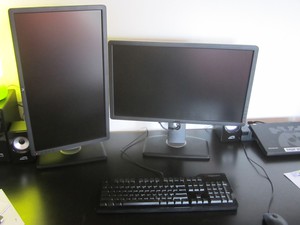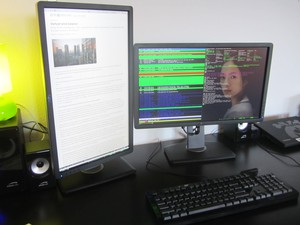New screens
I have a pair of new monitors (Dell U2312HM, find them here). I used to have one somewhat cheap 18.5" widescreen with 1366x768 (which is the same resolution as my Thinkpad X220), but reading long texts or working long hours really tired my eyes a lot.
The new screens have nice 23" IPS panels with great viewing angles. But most important of all, I can adjust the height of the screens and rotate them. Now my desk looks like this:
The X220 can only have two monitors connected at once. Also, the Docking Station's DVI output is single link. Thus, I connect one of the monitors via VGA and the other via DVI.
I use a simple shell script that is invoked when I press Fn+F7. Note that you have to turn off the LVDS1 internal display first before you can activate the two screens at once.
if [ $(xrandr -q | grep -c " 1920x1080 60.0 +") -eq 2 ]; then
xrandr --output LVDS1 --off
xrandr --output HDMI3 --auto --rotate left --output VGA1 --auto --right-of HDMI3 --primary
else
xrandr --output VGA1 --off --output HDMI3 --off
xrandr --output LVDS1 --auto
fi
X220's UMTS card
I've been toying around with the UMTS module in my X220 lately. I got a pre-paid SIM from blau.de, who offer 24h UMTS flatrates for 2,40 EUR. (This is probably my use case: Being somewhere without internet access for a day or two. This only happens so often, so I don't want a "real" flat.)
My UMTS card is manufactured by Sony Ericsson and connected via internal USB:
$ lsusb -v -s 004:003
...
idVendor 0x0bdb Ericsson Business Mobile Networks BV
idProduct 0x1911
The installation is easy: Just insert the SIM card behind the battery
as shown
here.
Add yourself to the dialout group, log in again, and you're set.
You can first connect to your device using chat or picocom (which
you can be terminated via C-a C-x). To ask if you can use the SIM
without PIN, send the AT+CPIN? command:
$ picocom /dev/ttyACM0
...
AT+CPIN?
+CPIN: READY
If you're not ready to go, I would disable the PIN request using a regular phone. (I did.)
Dialling out is easy. I set up two profiles in the /etc/wvdial.conf
that allow me to switch between "pay per megabyte" and "dayflat":
[Dialer blau]
Modem = /dev/ttyACM0
Init1 = AT+CGDCONT=1,"IP","internet.eplus.de"
Stupid mode = 1
phone= *99#
Username = blau
Password = blau
[Dialer tagesflat]
Modem = /dev/ttyACM0
Init1 = AT+CGDCONT=1,"IP","tagesflat.eplus.de"
Stupid mode = 1
phone= *99#
Username = blau
Password = blau
The rest happens automatically, once you invoke wvdial blau or
wvdial tagesflat. (Note you have to execute these with root
privileges because they want to modify pppd-related config files.)
Most probably you want the follow-up command route add default dev
ppp0 to route all traffic via the ppp0 interface.
In a test run I got a downstream speed of 190KB/s (city perimeter). Working over SSH is not painful at all.
I also played around with gammu a little bit.
$ gammu --identify
Device : /dev/ttyACM0
Manufacturer : Lenovo
Model : unknown (F5521gw)
Firmware : R2A07
The Wammu interface is nice, it can even receive SMS. But sending SMSes failed so far:
$ echo "Das ist ein Test" | gammu --debug textall --debug-file /tmp/gammu \
sendsms TEXT +491785542342
...
1 "AT+CMGS=28"
2 "> 079194710716000011000C919471584532240000FF10C4F01C949ED341E5B41B442DCFE9^Z"
3 "+CMS ERROR: 500"
... which is somewhat of an "generic error". Maybe sending SMS is not supported at all. I'll look into that later.
Also, I'll have a look whether my Card supports GPS information retrieval. Thinkwiki claims a similar model does this. Interesting.
Update: Actually, I forgot one thing. I keep the following two entries in my /etc/wvdial.conf:
[Dialer on]
Modem = /dev/ttyACM0
Init1 = AT+CFUN=1
[Dialer off]
Modem = /dev/ttyACM0
Init1 = AT+CFUN=4
The actual sequence is now: wvdial on && wvdial blau. The AT+CFUN=1 will
activate the radio equipment, which is necessary. And, suddenly, also SMS delivery works! :-)
New X220
I got a brand new Thinkpad X220 on thursday. I'm not much into hardware, I think it should mainly work. I have a model with 4 GB of RAM, an i7 at 2.7 GHz, UMTS preinstalled, SSD instead of a HDD and an IPS panel. It's a really nifty thing.
Paying the extra money for the SSD is totally worth it. Everything happens instantaneous. The bootup process is down to five seconds. The IPS panel is really worth it, too. ThinkPads have long been criticized for their bad displays – with the new panel at full brightness, my regular screen looks really dim and grey...
The Debian netinstall works smoothly. I haven't come around to testing all the stuff like the DisplayPort connectors, Bluetooth, UMTS, USB 3.0. But the usual stuff works out of the box.
However, there are major problems with the power management of both
the graphics card and the whole system, the latter one being a
regression in the recent 3.0 and 3.1 kernel series regarding
ASPM.
Currently I'm using the 3.1.0-1-amd64 kernel with the
pcie_aspm=force boot parameter. I cannot really see a difference in
power consumtion when varying this parameter, though.
A major thing,
however, is re-enabling the RC6 mode of the graphics chip. This alone
saves more than 4W when the computer is in an idle state. My
/etc/modprobe.d/i915-kms.conf looks like this now:
options i915 modeset=1
options i915 i915_enable_rc6=1
options i915 i915_enable_fbc=1
options i915 lvds_downclock=1
Suspend/resume works fine, no flickering effects. I use the following command to find out the current power consumption:
while sleep 1; do
awk '{printf"%.2f\n",$1/-1000}' < /sys/devices/platform/smapi/BAT0/power_now;
done
This requires the tp_smapi kernel module to be loaded. With full
brightness (0) and while writing this blog article, the consumption is at
~12W; with medium brightness (8) it's ~8.5W; at the lowest brightness
(15) it's ~8W; With the display completely turned off, it's ~6.5W.
There are people who
claim
they only have an ~5.4 power consumption. If you have any other hints
on this or if you own an X220 yourself, I'd be interested in the details.

